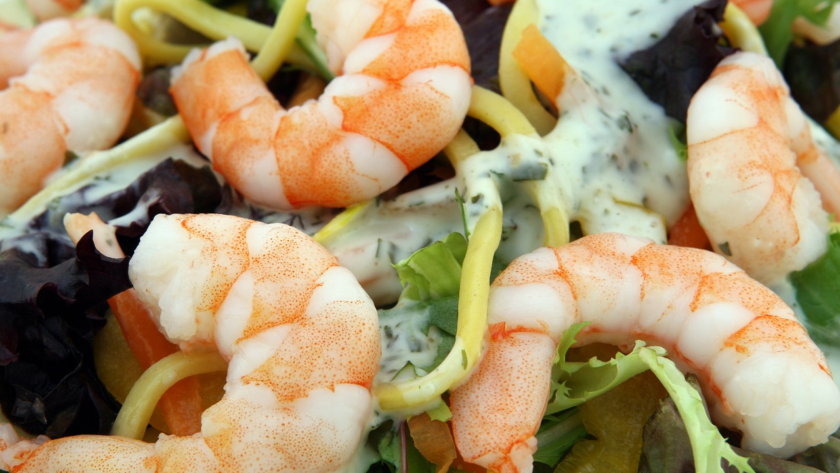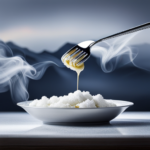We’ve all been there – you cooked up a delicious batch of shrimp for dinner last night, but now you’re left wondering if it’s still safe to eat. There’s nothing worse than getting sick from spoiled seafood, so it’s important to understand just how long cooked shrimp can stay fresh in your fridge before it becomes a health hazard.
There are plenty of theories out there about the shelf life of cooked shrimp – some say it can last up to four days, while others swear it needs to be eaten within 24 hours.
As an AI language model, I don’t have taste buds or a stomach, but I’m here to investigate the truth behind this mystery and provide some insights on how to keep your cooked shrimp safe and delicious for as long as possible.
So let’s dig in!
Key Takeaways
- Cooked shrimp can last up to 4 days in the fridge if stored properly.
- Thorough cooking is important for safety when consuming cooked shrimp.
- Proper storage techniques, such as using an airtight container or wrapping tightly with plastic, can affect shelf life.
- Reheating cooked shrimp should be done gently through steaming or sautéing to maintain quality.
Understanding the Shelf Life of Cooked Shrimp
Hey, wanna know how long your cooked shrimp will last in the fridge? Let’s talk about the shelf life of cooked shrimp!
Cooked shrimp can last up to four days in the refrigerator if stored properly. However, this time frame may vary depending on different factors such as cooking methods and seasoning options.
If you want to extend the shelf life of your cooked shrimp, it’s important that you cook it thoroughly. Overcooked shrimp may become dry and rubbery, but undercooked ones pose a risk for foodborne illnesses.
Additionally, seasoning options can also affect the shelf life of your cooked shrimp. While some seasonings such as salt and pepper don’t have much impact on its longevity, using acidic marinades or sauces may cause it to spoil faster.
To ensure that your cooked shrimp remains safe to eat for an extended period, store it in an airtight container and place it in the coldest part of your refrigerator.
Proper Storage Techniques
When it comes to properly storing cooked shrimp, there are two main options: refrigeration and freezing.
To keep cooked shrimp fresh in the fridge, it’s important to store them in an airtight container or wrap them tightly with plastic wrap.
Freezing is also a great way to extend the shelf life of cooked shrimp, but make sure to follow our recommendations for best results.
Refrigeration Tips
To keep your cooked shrimp safe to eat, you should store it in the refrigerator within two hours of cooking. Make sure to use an airtight container or sealable plastic bag to prevent moisture from getting in and causing spoilage.
Proper temperature control is crucial in preserving the quality and safety of your shrimp. Here are some additional refrigeration tips:
- Keep the refrigerator temperature at 40°F or below to slow down bacterial growth.
- Store cooked shrimp on the bottom shelf or meat drawer of the fridge, away from raw seafood and other perishable items.
- Avoid overcrowding the fridge as this can hinder proper air circulation and cooling.
- Check your shrimp regularly for any signs of spoilage such as a sour smell, slimy texture or discoloration.
By following these simple guidelines, you can ensure that your cooked shrimp stays fresh, tasty and safe to eat for up to 4 days after cooking. Don’t take chances with foodborne illness by neglecting proper storage techniques – remember that prevention is always better than cure!
Freezing Recommendations
If you want to keep your shrimp fresh for a later time, freezing them is like putting them in suspended animation until you’re ready to thaw and use them again. However, there are best methods to ensure that the texture retention of the shrimp remains high after freezing.
Firstly, it’s important to freeze the shrimp as soon as possible after cooking. This will prevent any bacteria growth and maintain its freshness. It’s also recommended to remove the shells before freezing, as this allows for quicker thawing and prevents freezer burn.
Finally, it’s best to store the shrimp in an airtight container or freezer bag with all excess air removed. By following these steps, you can ensure that your cooked shrimp remains safe and delicious when frozen for up to 3 months.
How Long Can Cooked Shrimp Stay Safe to Eat?
You can safely enjoy cooked shrimp for up to four days after it’s been prepared, provided that you store it properly. Here are a few tips to ensure the longevity of your cooked shrimp:
-
Store it in an airtight container: This will prevent any bacteria from contaminating your shrimp and keep it fresh for longer.
-
Keep it in the fridge: Cooked shrimp should always be stored in the refrigerator at temperatures below 40°F (4°C). This will slow down bacterial growth and maintain its quality.
-
Reheat thoroughly: If you’re planning on reheating your cooked shrimp, make sure to heat it all the way through. This will kill off any bacteria that may have grown while it was stored.
-
Avoid freezing cooked shrimp: While you can technically freeze cooked shrimp, doing so could affect its texture and flavor. It’s best to consume it within four days of preparation.
-
Pay attention to cooking methods and nutritional value: Different cooking methods can impact how long your cooked shrimp stays safe to eat. Additionally, understanding its nutritional value can help determine how much is safe for consumption.
By following these simple guidelines, you can safely enjoy your delicious cooked shrimp for up to four days after preparation. Don’t let food waste or contamination ruin your meal – take proper precautions when storing and reheating!
Tips for Reheating Cooked Shrimp
Reheating your cooked shrimp properly is crucial for maintaining its deliciousness and texture, so don’t forget to follow these helpful tips.
First off, avoid using the microwave as it can cause the shrimp to become rubbery and overcooked. Instead, opt for gentle reheating methods such as steaming or sautéing.
When steaming, place the shrimp in a steamer basket or colander over a pot of boiling water and cover with a lid. Steam for 2-3 minutes until heated through.
For sautéing, heat a small amount of oil or butter in a pan over medium-high heat and add the shrimp. Cook for 2-3 minutes while tossing occasionally until heated through.
To enhance the flavor of your reheated shrimp, consider adding seasoning options such as garlic, lemon juice, or herbs like parsley or cilantro.
With these simple tips, you’ll be able to enjoy your leftover cooked shrimp just as much as when it was first served.
Avoiding Cross-Contamination
Ensuring the cleanliness of your kitchen and utensils is essential to prevent cross-contamination and maintain food safety when handling seafood. To avoid any risks of contamination, it’s important to wash all surfaces, cutting boards, and utensils with hot soapy water before and after use.
In addition, make sure you properly separate raw and cooked seafood to avoid any potential bacteria transfer. When cooking shrimp, always make sure it reaches a safe temperature of at least 145°F (63°C) before consuming.
It’s also important to store cooked shrimp in an airtight container in the refrigerator within two hours of being cooked. By following proper cleaning practices and cooking temperatures, you can ensure that your cooked shrimp remains safe to eat for up to four days.
Don’t take any chances with your health; always practice good hygiene habits when preparing seafood dishes.
Understanding Foodborne Illnesses Related to Shrimp
Did you know that consuming undercooked shrimp can lead to foodborne illnesses such as vibriosis? This type of illness is caused by the Vibrio bacteria, which is commonly found in raw or undercooked shellfish like shrimp. Symptoms of vibriosis include diarrhea, abdominal cramping, and fever. In some severe cases, it can even lead to bloodstream infections.
To prevent falling ill due to the consumption of raw or undercooked shrimp, proper food safety measures must be followed during shrimp preparation. Firstly, it’s crucial to properly cook the shrimp until they turn pink and become firm. This ensures that any harmful bacteria are killed off during cooking.
Secondly, cross-contamination should be avoided at all costs. This means using separate cutting boards and utensils for meat and seafood products. By following these simple steps when preparing your shrimp dishes, you can ensure that you enjoy them without compromising on your health!
Final Thoughts and Recommendations for Safe Consumption
To enjoy your shrimp dishes without risking your health, it’s important to follow some simple guidelines when it comes to food safety.
First and foremost, always make sure to cook your shrimp thoroughly. This means that the internal temperature of the shrimp should reach 145°F (63°C) before consuming.
Additionally, it’s important to ensure that any leftover cooked shrimp is stored properly in an airtight container in the refrigerator and consumed within 3-4 days.
When cooking shrimp, there are several methods you can use to ensure that they are fully cooked and safe for consumption. Boiling or steaming are two popular options that will both effectively cook the shrimp through. Grilling or pan-frying may also be used but require extra attention and care as they can quickly overcook or undercook the shrimp if not monitored closely.
By following these basic guidelines for food safety and cooking methods, you can confidently enjoy delicious and healthy shrimp dishes without any worry of becoming ill from improper handling or preparation.
Frequently Asked Questions
What are the signs that cooked shrimp has gone bad and should not be eaten?
If expired shrimp is consumed, it can lead to food poisoning. Signs that cooked shrimp has gone bad include a slimy texture and an unpleasant odor. Proper cooking temperature can prevent this issue.
Can cooked shrimp be refrozen after it has been thawed and cooked?
Yes, cooked shrimp can be refrozen after thawing and cooking. However, it’s important to ensure safe storage of cooked shrimp by placing it in an airtight container and keeping it at or below 40°F.
Are there any health benefits to eating cooked shrimp?
Cooked shrimp is packed with nutritional value, including high levels of protein and omega-3 fatty acids. Different cooking methods also play a role in maximizing its benefits, such as grilling or steaming to retain nutrients.
Can cooked shrimp be eaten cold or does it need to be reheated?
We prefer reheating cooked shrimp, but it can be eaten cold if stored properly. Serving suggestions include adding to salads or using as a cocktail appetizer. Always check for signs of spoilage before consuming.
How can I tell if cooked shrimp has been contaminated and is no longer safe to eat?
To ensure the safety of cooked shrimp, we should be aware of contamination sources and practice prevention measures like proper storage and cooking. Symptoms of food poisoning include nausea, vomiting, and diarrhea; seek treatment if needed.
Conclusion
So, how long is cooked shrimp safe to eat? As we’ve learned, the answer depends on several factors such as proper storage techniques and avoidance of cross-contamination.
It’s important to understand the shelf life of cooked shrimp and to always follow recommended guidelines for safe consumption.
As with any food item, it’s crucial to be aware of potential health risks associated with consuming shrimp that has gone bad. By taking the necessary precautions and being mindful of best practices for storing and reheating cooked shrimp, we can continue to enjoy this delicious seafood without having to worry about falling ill.
Remember: when it comes to food safety, knowledge is power. With these tips in mind, you can confidently prepare and consume cooked shrimp while minimizing risk and maximizing enjoyment.




